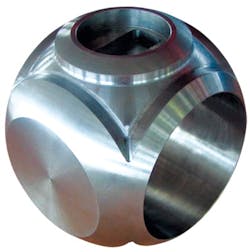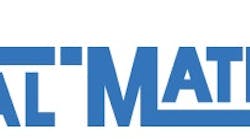Although geothermal energy generation is a growing renewable resource, it still presents challenges for equipment suppliers in terms of controlling the often harsh geothermal fluids. A geothermal plant can use direct steam, hot water, or a mixture of steam and water, but in all cases, the fluids can contain abrasive and corrosive chemicals and minerals that can foul, erode and damage control valves. For many years, through-conduit slab gate valves have been employed to isolate the well heads in the aforementioned services. In recent years, QuadroSphere trunnion ball valves have proven to be an ideal choice for hot water (geothermal brine) services.
Valves for Geothermal Brine Service
The Coso Geothermal Field, situated northeast of Bakersfield, Calif., consists of four power plants. Construction began in the 1980s; today there are 80 to 90 operating production wells feeding the power plants, which utilize double-flash technology for steam extraction. In this process, geothermal fluid is sprayed into a separator tank held at a low pressure, causing some of the fluid to rapidly vaporize into steam. The steam then drives a turbine and generator. The remaining liquid is flashed again in a second tank (double flash) to extract additional energy.
The wellhead pressures at Coso can measure up to 500 psi, with temperatures reaching 500°F. The fluids produced are moderate saline chloride brines with total dissolved solids (TDS) from 7,000 to 18,000 ppm, similar to brackish water with sediment. As is the case in many geothermal fields, the wellhead valves are through-conduit slab gate valves, which have been used for many years even though they require regular repair and maintenance due to leakage caused by sand erosion and calcium carbonate mineral deposits in the seating areas of the valves.
The Salton Sea area of California also is home to several power plants that successfully employ geothermal brine as their source of energy. Ormat Geothermal operates plants in East Mesa and Brawley, where the brine wells produce hot fluid containing TDS (similar to seawater), plus sand and trace minerals, which cause a significant amount of salt buildup in the wellhead valves and piping. The severe and aggressive nature of this geothermal brine, together with the pressure and temperature conditions encountered at the geothermal fields, cause a concrete-like buildup of scale and calcium, thereby prohibiting the use of traditional trunnion ball valves in brine withdrawal and re-injection services.
Demonstrated Success
In 2007, several of the production and re-injection wells in East Mesa, Brawley and the northern Nevada geothermal fields successfully were fitted with 10 NPS Class 150, 12 NPS Class 400 and 16 NPS Class 600 peek-seated trunnion ball valves. These full-port valves were manufactured to the forged trunnion ball valve requirements given in ASME B16.34 and American Petroleum Institute (API) 6D valve standards. Their unrestricted flow path provided increased flow and less turbulence, so the valves were less susceptible to the buildup of mineral deposits and the fouling and wear of valve internals.
Ball Geometry
The ball valve is well suited to geothermal brine service due to its ball geometry. All non-essential ball surfaces are recessed. The remaining spherical surfaces on the ball form a raised sealing surface in both the open and closed positions, which protects the valve sealing surfaces whenever the valve is in the fully open or closed position. During its operation, however, the edges on the ball’s four raised seating areas clean and wipe scale and debris from the seating surfaces and into the recessed areas on the ball, which do not make contact with the seats when the ball rotates.
During operation, the valve also provides additional flow paths for the fluid and any particulates to flush from the inner body during operation. This cleaning and flushing occurs whenever the ball is moving from the closed to open position. Additional benefits are realized from the technology because the approximately 70% less ball-to-seat surface contact area reduces seat wear, as well as the valve’s running torque. For increased wear resistance, the stainless steel ball is hard-chrome plated. The result is a self-cleaning, resilient seated valve with the longevity of a metal-to-metal seated valve.
This trunnion ball valve provides bi-directional resilient sealing. The metal seat rings float axially in body recesses called seat ring pockets and are pre-loaded by compression seat springs. The metal seat rings react to the upstream line pressure to seal tightly against the ball. Under low-pressure conditions, the compression springs provide an initial sealing force to the back of the metal seat ring. Then, as line pressure is introduced into the annular area between the seat O-ring and the seat insert, a pressure force develops, which holds the resilient seat insert against the ball to create a tight seal. Resilient seat ring inserts can be made from various plastic-based compounds including glass-filled or carbon fiber-reinforced polytetrafluoroethylene.
DBB Seating & Forged Construction
Standard configuration QuadroSphere ball valves are equipped with a seat on each end of the valve to provide double block and bleed function and provide independent isolation of flow coming from either side of the valve. In the event the inner body cavity pressure exceeds the line pressure plus the spring force on either seat ring, the valve seat ring automatically will move away from the ball and bleed fluid back into the pipeline to prevent any possibility of a potentially damaging overpressure condition inside the body chamber of the valve.
The platform from which the valves are made consists of an API 608 three-piece forged body with upper and lower bonnet plus forged seat rings and stem. The benefits of forged construction include the elimination of porosity and cracks that are sometimes associated with cast products. The secondary heating and forming processes that go into making forged components add further grain structure realignment, thereby providing additional structural integrity to the part. Moreover, the forging process ensures superior surface finishes and eliminates the need for weld repairs.
Because these trunnion ball valves require 90 degrees of rotation to go from open to closed, they can be equipped with a variety of quarter-turn actuators, including manual gear, pneumatic, electric, hydraulic and electro-hydraulic types for remote or automatic operation. For instance, a gear actuator that multiplies the hand wheel torque many times over enables the valve to be operated with a torque of about 200 N-m. Gear actuators also are easily adaptable for an electric motor or automatic operation.
By incorporating the design features of these trunnion ball valves, several geothermal facilities have gained improved valve performance and overall system reliability while reducing maintenance frequency.


